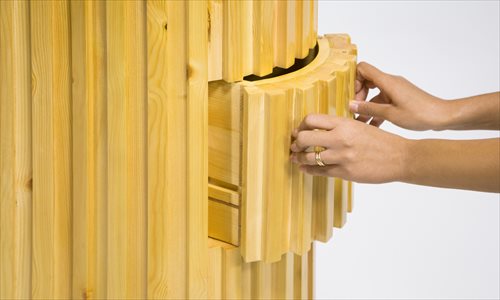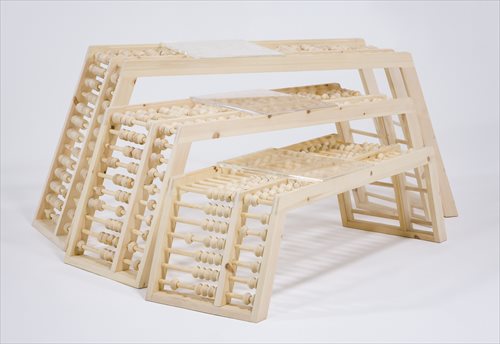HOME >> METRO SHANGHAI
Chinese designers in Shanghai learn value of Swedish-style
By Qi Xijia Source:Global Times Published: 2016-2-15 18:43:01
Sweden is European Union's third-largest country by landmass, with 70 percent of land covered in forest, which also makes it the third-largest exporter of sawn timber.
To introduce the value of using Swedish pine in the production of environmentally friendly furniture, Design for Sustainable Living, a cooperation project between Swedish wood promoters and Chinese designers, was recently held in Shanghai.
The project started in May of last year, when seven renowned Chinese designers were invited to Sweden to visit local forests and sawmills, learn about forest management and spend time at the Design Institute at Umeå University and the Carl Malmsten Furniture School in Sweden.
"This is a great project where minds, visions and material meet over borders and cultures. It is a project which fits into the increased cooperation and exchange between Sweden and China when it comes to design and innovation," said Viktoria Li, Consul General of Sweden in Shanghai.
Protection and expansion
Unlike industrialized nations such as China and the US that rely largely on plastics and metals for its furniture, architecture and interior designs, with vast natural resources Sweden consumes a large amount of wood for such purposes. "More than 90 percent of one-family houses being built in Sweden today are wood, and 10 percent of our multi-storey buildings are wood," Charlotte Apelgren, Director Interior and Design of Swedish Wood told the Global Times.
Far from being on the verge of extinguishing one of its greatest natural resources, the Swedish forest industry knows that its future is directly linked to the protection and expansion of its forests. This, in combination with effective environmental laws, ensures that more trees are planted than harvested.
One Chinese designer attending the Shanghai event noted that he was deeply impressed that in Sweden, for each tree cut down at least two new ones are planted. Apelgren confirmed that the mandatory requirement for regeneration after felling has been a central policy in Swedish legislation since 1903.
"Since then our forest resources have doubled. Annually, 170,000 hectares are planted with some 370 million seedlings," said Apelgren.
Sustainable forest management in Sweden also includes respecting its biological diversity, the ecology of the species living within it, and the communities affected by forests.
"In Sweden, site-specific forestry is applied, taking into consideration the varying conditions of the individual site. This ensures a greater variety and minimizes negative effects on animal and plant life," said Apelgren.
Accordingly, old trees are saved, dead wood is left on the ground and clear-cutting is almost entirely abandoned. Approximately 4 million hectares of productive forest land are protected as national parks, nature reserve habitat protection areas and nature conservation agreements.
"It is estimated that large industrial forest enterprises now leave 10 percent of potential harvest standing for ecological reasons," said Apelgren.
A process, not a product
Characterized by simplicity, minimalism and functionality, Swedish design gives off a warm natural feeling that is appreciated during their country's long cold winters. This unique concept is now drawing more interest from Chinese designers and furniture makers.
"For us, design is a process, not just a product," said Li. "It is hence no surprise that an organic material like wood is one of our most preferred materials for our houses and our furniture and our design."
Over the past three years, Nordic Design and Innovation Week in Shanghai has developed into a large-scale event, creating multinational platforms for exchange and inspiration in the fields of design. "This year Sweden will be an official partner of the Shanghai Design Fair in March. But what we really will exhibit are solutions for a more sustainable and beautiful life," said Li.
According to statistics from Swedish Wood, exports of conifer wood from Sweden to China have grown steadily in recent years. Year 2011 was the first year that exports exceeded 100,000 m³, rising year-on-year. In 2015, it estimates that exports amounted to 530,000 m³.
"China is judged to be a market with the greatest potential for Swedish sawn wood products. Most Swedish sawmills export to China and many of the biggest companies have local sales offices in China," said Apelgren.
Apelgren has also seen large Chinese wood furniture manufacturers express an interest in cooperating with Swedish designers. "Next autumn, Swedish Wood will, together with the Swedish Carl Malmsten Furniture School, run a project where Swedish students will design furniture for Chinese furniture manufacturers."


Newspaper headline: Better living through lumber
To introduce the value of using Swedish pine in the production of environmentally friendly furniture, Design for Sustainable Living, a cooperation project between Swedish wood promoters and Chinese designers, was recently held in Shanghai.
The project started in May of last year, when seven renowned Chinese designers were invited to Sweden to visit local forests and sawmills, learn about forest management and spend time at the Design Institute at Umeå University and the Carl Malmsten Furniture School in Sweden.
"This is a great project where minds, visions and material meet over borders and cultures. It is a project which fits into the increased cooperation and exchange between Sweden and China when it comes to design and innovation," said Viktoria Li, Consul General of Sweden in Shanghai.
Protection and expansion
Unlike industrialized nations such as China and the US that rely largely on plastics and metals for its furniture, architecture and interior designs, with vast natural resources Sweden consumes a large amount of wood for such purposes. "More than 90 percent of one-family houses being built in Sweden today are wood, and 10 percent of our multi-storey buildings are wood," Charlotte Apelgren, Director Interior and Design of Swedish Wood told the Global Times.
Far from being on the verge of extinguishing one of its greatest natural resources, the Swedish forest industry knows that its future is directly linked to the protection and expansion of its forests. This, in combination with effective environmental laws, ensures that more trees are planted than harvested.
One Chinese designer attending the Shanghai event noted that he was deeply impressed that in Sweden, for each tree cut down at least two new ones are planted. Apelgren confirmed that the mandatory requirement for regeneration after felling has been a central policy in Swedish legislation since 1903.
"Since then our forest resources have doubled. Annually, 170,000 hectares are planted with some 370 million seedlings," said Apelgren.
Sustainable forest management in Sweden also includes respecting its biological diversity, the ecology of the species living within it, and the communities affected by forests.
"In Sweden, site-specific forestry is applied, taking into consideration the varying conditions of the individual site. This ensures a greater variety and minimizes negative effects on animal and plant life," said Apelgren.
Accordingly, old trees are saved, dead wood is left on the ground and clear-cutting is almost entirely abandoned. Approximately 4 million hectares of productive forest land are protected as national parks, nature reserve habitat protection areas and nature conservation agreements.
"It is estimated that large industrial forest enterprises now leave 10 percent of potential harvest standing for ecological reasons," said Apelgren.
A process, not a product
Characterized by simplicity, minimalism and functionality, Swedish design gives off a warm natural feeling that is appreciated during their country's long cold winters. This unique concept is now drawing more interest from Chinese designers and furniture makers.
"For us, design is a process, not just a product," said Li. "It is hence no surprise that an organic material like wood is one of our most preferred materials for our houses and our furniture and our design."
Over the past three years, Nordic Design and Innovation Week in Shanghai has developed into a large-scale event, creating multinational platforms for exchange and inspiration in the fields of design. "This year Sweden will be an official partner of the Shanghai Design Fair in March. But what we really will exhibit are solutions for a more sustainable and beautiful life," said Li.
According to statistics from Swedish Wood, exports of conifer wood from Sweden to China have grown steadily in recent years. Year 2011 was the first year that exports exceeded 100,000 m³, rising year-on-year. In 2015, it estimates that exports amounted to 530,000 m³.
"China is judged to be a market with the greatest potential for Swedish sawn wood products. Most Swedish sawmills export to China and many of the biggest companies have local sales offices in China," said Apelgren.
Apelgren has also seen large Chinese wood furniture manufacturers express an interest in cooperating with Swedish designers. "Next autumn, Swedish Wood will, together with the Swedish Carl Malmsten Furniture School, run a project where Swedish students will design furniture for Chinese furniture manufacturers."


Furniture designs using Swedish wood made by Chinese designers
Photos: Courtesy of Swedish Wood
Newspaper headline: Better living through lumber
Posted in: Metro Shanghai